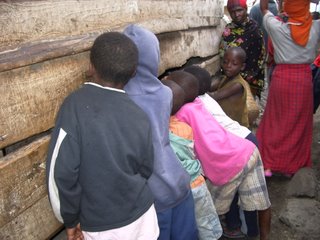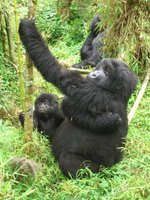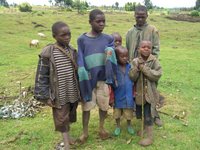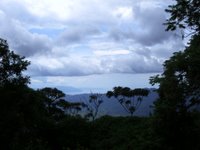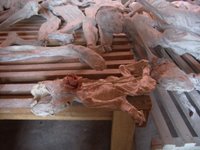Middle Europe in June
I'm sitting in the kitchen of my hostel in Prague which is decorated with communist-era furniture and photo
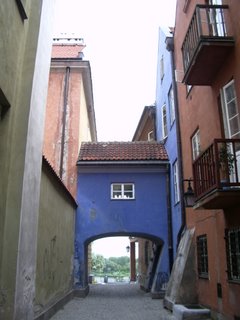 graphs, not remnants of a past era but purposly placed as an artistic statement. Today I took the day off after weeks of wondering around lost in narrow cobblestone alleyways, over medieval bridges, through lavishly decorated castles and, less majestically, by countless stands of touristy "plastic crap" as my Dad would call it. I've been in E. Europe for nearly a month now and have enjoyed the history and culture and art while at the same time have been repelled by the commercalization and tourist-trap aspects present in every town. Watching a golf cart full of fat white lazy tourists pass a buggy drawn by two massive horses over a cobblestone street is at the same time bewildering and depressing.
graphs, not remnants of a past era but purposly placed as an artistic statement. Today I took the day off after weeks of wondering around lost in narrow cobblestone alleyways, over medieval bridges, through lavishly decorated castles and, less majestically, by countless stands of touristy "plastic crap" as my Dad would call it. I've been in E. Europe for nearly a month now and have enjoyed the history and culture and art while at the same time have been repelled by the commercalization and tourist-trap aspects present in every town. Watching a golf cart full of fat white lazy tourists pass a buggy drawn by two massive horses over a cobblestone street is at the same time bewildering and depressing.My first stop in Poland was Warsaw where I arrived by
plane from Kenya. In Warsaw I saw my first opera (I expect
Nora to take me to much better ones when I get back to San Francisco!), went shopping at real department stores for the first time in months and enjoyed my first European streets, including the one with the blue building on the left. Warsaw is incredible because it was completely leveled during WWII and has been rebuilt from scratch so successfully that it has been named a UNESCO World Heritage Site. I was able to view many monuments to WWII (Holocaust is
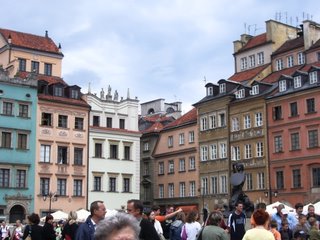 n't a term they use in Poland very often) and used Warsaw as my base for visiting the beautiful memorial at Treblinka, which consists of thousands of rocks jutting from the ground like gravestones. While in Warsaw I also saw the Pope, which is always exciting. Yeah, see that golf cart, that's him!!
n't a term they use in Poland very often) and used Warsaw as my base for visiting the beautiful memorial at Treblinka, which consists of thousands of rocks jutting from the ground like gravestones. While in Warsaw I also saw the Pope, which is always exciting. Yeah, see that golf cart, that's him!!From Warsaw I took a train south to Lublin from where I visited the Majdanek Concentration Camp and enjoyed a less crowded and off the beaten trail Polish city. This is where I visited my first castle, the best aspect of which was the Chapel of Holy Trinity which is decorated with polychrome Russo-Byzantine frescoes painted in 1418 (thank you lonely planet). Sorry no pictures allowed. From Lublin I traveled to Krakow, the "gem of Poland." There was a dragon festival on and so it was convincingly like the scene in Shrek 2 when Shrek goes to meet Fiona's parents in their fairytale castle, comple
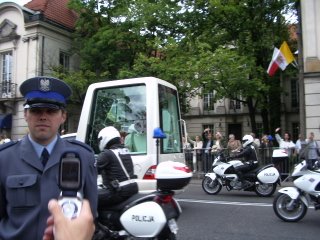 te with stands of pretzels, stuffed dragons and plastic toy swords and knights who would rather have 5 zlotys than your heart. I had a surreal moment (one of many) after an early morning jog when I found myself at the foot of the red brick walls of the most beautiful castle. I've had lots of moments where I sort of get overwhelmed and teary eyed and can't believe that I'm actually here seeing and experiencing all these amazing things. On a more somber note I visited Auschwitz-Birkenau, a true testament to the organization and efficiency of the Nazi party. It was strange to see the actual piles and piles of victims' hair, shoes, bags and glasses that are such popular images of the Holocaust. Same thing with the barbed wire on the fence stretching around the vast concentration camp. Right when I reached the stone memorial, the last stop for visitors at the very furthest point of Birkenau it began to hail. I had only a raincoat and was soaked and cold as I left on bus from the infamous gate where prisoners were seperated upon arrival into groups that were to live and those that were to be sent to the gas chambers.
te with stands of pretzels, stuffed dragons and plastic toy swords and knights who would rather have 5 zlotys than your heart. I had a surreal moment (one of many) after an early morning jog when I found myself at the foot of the red brick walls of the most beautiful castle. I've had lots of moments where I sort of get overwhelmed and teary eyed and can't believe that I'm actually here seeing and experiencing all these amazing things. On a more somber note I visited Auschwitz-Birkenau, a true testament to the organization and efficiency of the Nazi party. It was strange to see the actual piles and piles of victims' hair, shoes, bags and glasses that are such popular images of the Holocaust. Same thing with the barbed wire on the fence stretching around the vast concentration camp. Right when I reached the stone memorial, the last stop for visitors at the very furthest point of Birkenau it began to hail. I had only a raincoat and was soaked and cold as I left on bus from the infamous gate where prisoners were seperated upon arrival into groups that were to live and those that were to be sent to the gas chambers.From Krakow I rook a bus down so
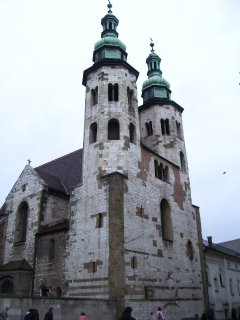 uth to do some hiking in the snow capped alp-like Tatras. It was truly one of the most beautiful locations I have ever been in. As I lay in a grassy field on a hill and looked up at the jagged white moutains on all sides and ate a swiss chocolate bar I began to cry from the beauty of it all. Looking through the dark and overgrown forest I could imagine being inspired to write about wolves eating grandmas or getting lost with my brother and coming upon the house of an evil witch. After three days of hiking nearly six hours a day I injured my knee and knew that it was time to move on. I came to Prague from Krakow by overnight train. There were wild red poppies growing on the side of the tracks. In the middle of the night we arrived at the Czech border and a border patrol officer politely knocked on our door and asked to see our passports. After he had glanced quickly through them he said thank you and wished us a safe journey. I was shocked. What, no attempts at extracting a bribe? No luggage searches for smuggled drugs? No standing in lines for an hour and paying $50 for an intricately decorated visa? No children begging or men trying to change money at horrible rates? Where
uth to do some hiking in the snow capped alp-like Tatras. It was truly one of the most beautiful locations I have ever been in. As I lay in a grassy field on a hill and looked up at the jagged white moutains on all sides and ate a swiss chocolate bar I began to cry from the beauty of it all. Looking through the dark and overgrown forest I could imagine being inspired to write about wolves eating grandmas or getting lost with my brother and coming upon the house of an evil witch. After three days of hiking nearly six hours a day I injured my knee and knew that it was time to move on. I came to Prague from Krakow by overnight train. There were wild red poppies growing on the side of the tracks. In the middle of the night we arrived at the Czech border and a border patrol officer politely knocked on our door and asked to see our passports. After he had glanced quickly through them he said thank you and wished us a safe journey. I was shocked. What, no attempts at extracting a bribe? No luggage searches for smuggled drugs? No standing in lines for an hour and paying $50 for an intricately decorated visa? No children begging or men trying to change money at horrible rates? Where am I?!!!!
am I?!!!!I arrived in Prague and found my hostel and have been here for nearly a week now. It is definately my favorite place I've been in this area of the world. It's a busy city mixing culture, art and a complicated history and politics so beautifully that it's almost overwhelming. I've been to more churches since arriving here than I have in my entire life combined. They are truly inspired works of art both outside and in with stone carvings, detailed stain glass, bright mosaics, and ancient frescoes depicting various scenes from the bible. I've also been enjoying museums, art galleries, and just walking around and stumbling upon strange buildings and statues. I've had the pleasure of seeing the dancing building, a work of architect Frank Ghery and various statues by the Czech artist David Cerny. Some of his stuff is very bizarre but it
 is all politically inspired and controversial, which I love. I also enjoyed visiting the Mucha Museum and seeing originals of all those turn of the century replicated theatre and cigarette posters gracing the walls of countless dorm rooms and cafes around the world.
is all politically inspired and controversial, which I love. I also enjoyed visiting the Mucha Museum and seeing originals of all those turn of the century replicated theatre and cigarette posters gracing the walls of countless dorm rooms and cafes around the world.Tomorrow I am visiting a church made of bones an hour away from Prague by train and the next day the Terezin Concentration Camp, the "reason" for my being here. From here I will travel to Munich, Germany my base for visiting Dachau.
Alright, well this is long enough!! I've been taking a ton of photos because it is so much easier to join the masses and walk around with a camera. I hope you enjoy.
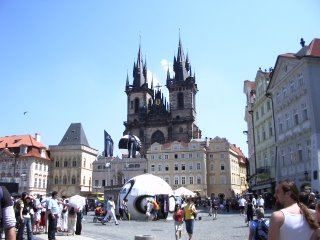
A chapel in the Old Town of Prague
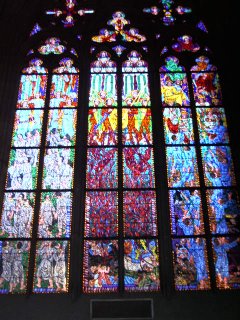
A stained glass window in the chapel at the castle in Prague
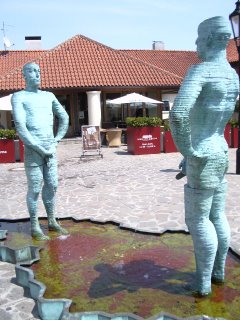
One of those great Cerny statues. You can text messages to the statue and it will pee out your message. The rest of the time it spells out famous czech literary quotes.

Cerny again. That's a t.v. tower and those are giant bronze babies. It was pretty bewildering because I didn't know what it was until I got back to the hostel and asked about it.
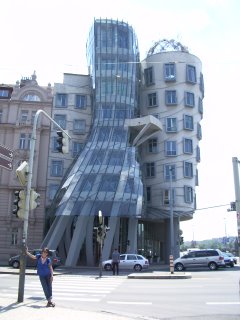
The dancing building by Frank Ghery.


